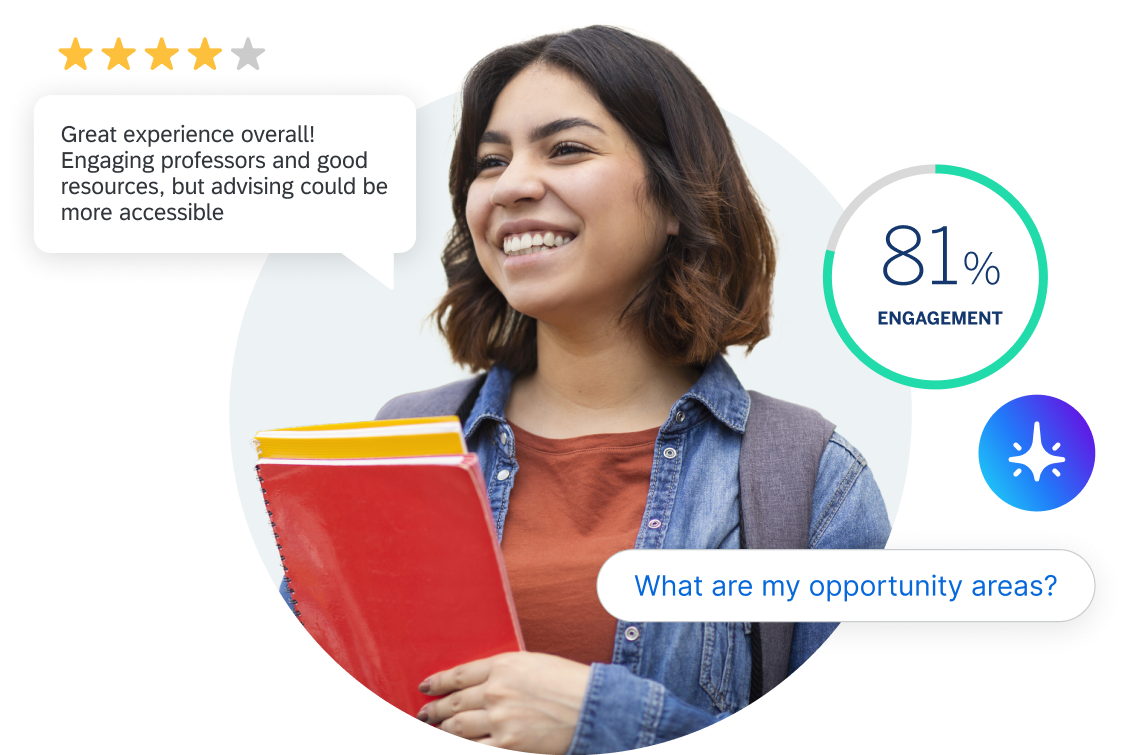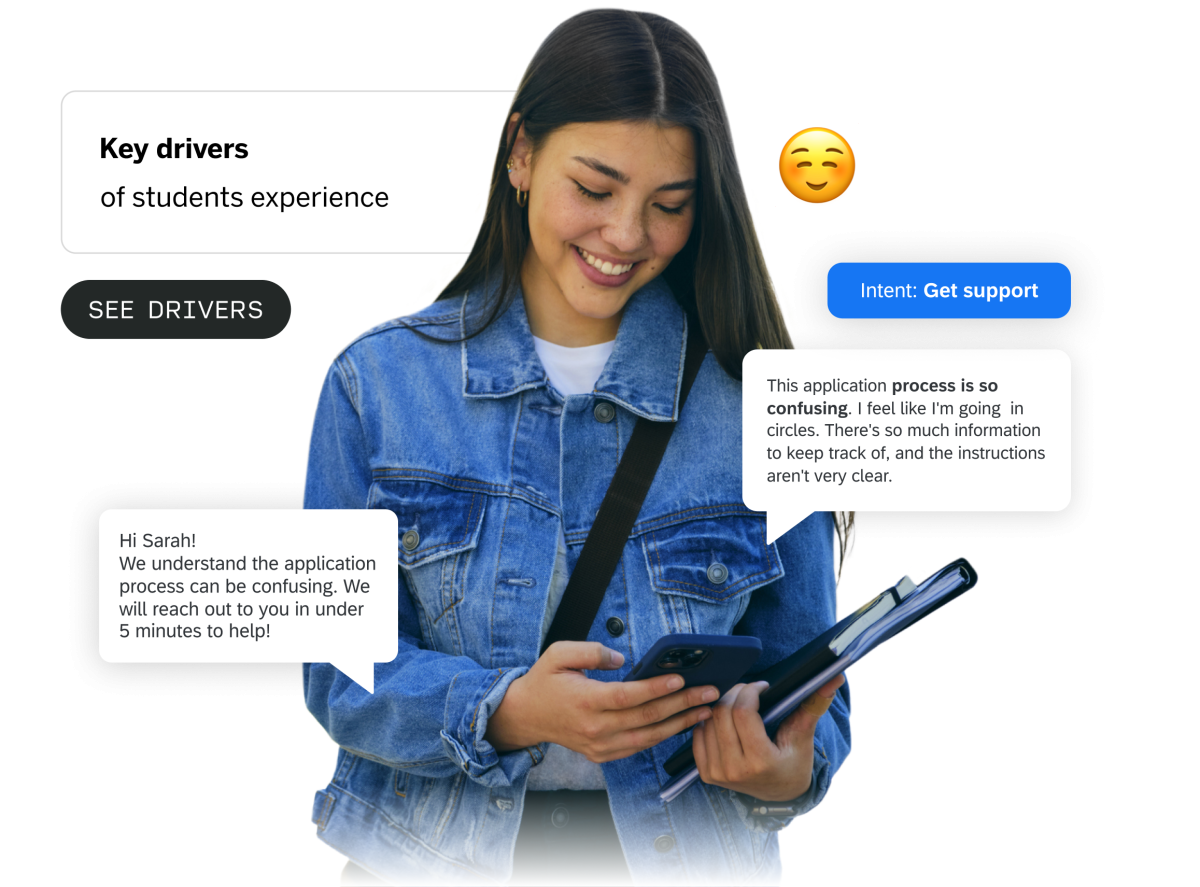What is the student experience?
The student experience is the sum of every interaction new, existing and prospective students have with an educational institution. The experience is built, brick by brick, across digital, physical and even emotional touchpoints – and it ultimately describes the way people think about their engagement with that school, college, or university.
This starts early, right from when a prospective student first researches potential good fits. It includes how the institution conveys itself during open days and campus tours, alongside every aspect of day-to-day student life and, ultimately, the post-course alumni experience.
That all includes, but is not limited to, things like:
- Research, application and onboarding processes
- Campus culture
- Community, clubs and accessibility of upcoming events
- Ongoing student well being
- Faculty and leadership and resources
- The quality of classrooms and facilities
- Digital learning environments and tools
- Online and in-person resources
- The experiences of their friends and peers
- How many opportunities students feel the institution unlocks
- Post-graduate life – including advice, support, and prospects
Why student experience is important
Higher education plays an important role in society, but educational institutions are, at the end of the day, businesses, so it pays to think about engagement and experience in similar terms to how any other organization might think about its customers. After all, if a university can’t attract and keep students, it will cease to function.
Because of that, curating and optimizing the student experience is vital. The success of an institution’s experience management will mean the difference between high or low enrollment engagement and retention figures, while a fully-optimized student journey will help turn alumni into advocates for years to come.
Managing the student experience means orchestrating touchpoints and journeys that enhance:
- Applications and enrollment - Building a reputation for quality at every step will mean more and more students vie for a place
- Retention and learning outcomes - Stronger programs and higher success rates will naturally increase as you focus on the various facets of the student experience
- Alumni advocacy - Happy, engaged pupils make for an alumnus keen to stay engaged with, promote, and even donate to the cause

Measuring the student experience
Building a best-in-class academic experience begins with understanding how things currently look. In any ongoing process, measuring and benchmarking are the first steps toward improvement.
Typically, this involves gathering student feedback, identifying pain points, and then working to improve things before gathering feedback again. But there are other inputs when it comes to measurement here – most of them involving turning the behavior of the student population into useful metrics:
Engagement metrics
- Class attendance and participation rates
- Digital learning environment analytics (including logins, and module completion)
- Extra curricular involvement (clubs, societies and volunteering)
Academic outcomes
- Retention vs dropout rates
- Year-to-year progression rates
- Course completion rates and average grades
Support and wellbeing indicators
- Use of student services (like counselling and career advisors)
- Wellbeing/mental health self-reports
Gathering student feedback
Student feedback plays an invaluable role in shaping the overall campus experience. But while traditional surveys still have their place in feedback cycles, approaches must focus on the digital side of student experience if they’re to avoid falling short.
Many institutions focus too heavily on past data from systems like CRM, web analytics, or marketing automations. This data may reveal what happened (like an increase in first-semester dropouts) but not why (for example, poor advising or lack of academic support).
The result here is difficulty in understanding student experiences, and an inability to act in real time when problems arise. Empowering staff to listen out for and fix frustrations as they happen is crucial for student success.
So, to truly understand student behavior and pain points, institutions need to capture – and understand – the student experience as it happens within the digital environment…
The importance of the digital student experience
As Whitnie Powell, Assistant VP, Enrollment Management & Student Services at IU Online puts it: “Today’s students are not the students of old. They live in a world in which everything is “always on” and only a click away.
“If we cannot adapt,” she says, “they will not wait. We must look at ways to establish seamless entry points and access, transparent information sharing, and clear pathways to graduation from the first contact.”
While many institutions often consider individual digital touchpoints in isolation (like applying, registering for courses, or accessing the learning management system), the reality is that a student’s digital experience is a series of connected interactions. And failing to improve these digital student journeys can have significant and widespread consequences:
- Decreased prospective student conversion from inquiry to application
- Fewer people enrolling due to difficult or unclear processes
- Increased frustration and less engagement through digital channels
- Lower persistence and retention rates when digital experiences become blockers
What’s important here is that these touchpoints and interactions add up to more than the sum of their parts – and they’re all connected. A prospective student might first encounter your institution through social media, then explore the website, attend a campus tour, and finally navigate the online application portal. That’s a bunch of touchpoints, but one journey.
Similarly, a current student’s experience could involve registering for classes, accessing online course materials, and interacting with student support services digitally. In traditional digital measurement, these moments are captured as isolated experiences – but to the student it’s one continuous process.
How to improve the digital student experience
To understand and build upon the digital student experience in higher education, we need to bring together information and insights from every online touchpoint. A unified view allows for more easily identifiable problems, personalized support, improved engagement and retention, and more effective resource allocation.
Here’s a three-step strategy for building best-in-class digital student experiences:
- Listen
- Understand
- Act
1. Listen
Here we need to deeply understand what prospective and existing students think. But in order to sort the signal from the noise, it’s important to map the student journey across a few key stages – and identify the critical questions that need to be answered:
Prospective students
How do people find information about programs? What is their experience with the application process? How effectively does the digital experience nurture them through the enrollment funnel?
New student onboarding
How easily can new attendees access onboarding information? Are they effectively guided through essential pre-arrival tasks? Do they feel supported and prepared for their first day?
Academic progress
How intuitive is the course registration process? How effectively can people navigate the Learning Management System (LMS)? Are they able to easily access academic advisory tools?
Next up, we need to put our ears to the ground and collect feedback. That means employing digital tools to help uncover opinions and behaviors that are both solicited and obvious, but also ones hidden in plain sight:
Active forms of feedback
- Website intercepts: Use targeted surveys on key website pages to get feedback
- Digital abandonment: Trigger a survey on specific digital journeys, such as application or course registration, when a student doesn’t complete their task to identify the reason for leaving and opportunities for intervention
- Always-on website feedback: Provide a persistent channel for students to submit feedback at any time.
- Content effectiveness: Implement mechanisms (e.g., thumbs up/down ratings) to assess the usefulness of digital content.
- Post-interaction surveys: Automatically send surveys after students use online services (like submitting a help ticket or registering for classes) to measure their effort to complete and satisfaction.
Passive forms of feedback
- Session replay: Capture how users interact with important student-facing websites (application portal, LMS, student portal) to understand their behavior and identify areas of frustration.
- Behavior tracking: Monitor clicks and scroll depth to gain insights into user navigation and engagement.

2. Understand
With student data flowing in, we need to turn it into insight. In the face of overwhelming data, key driver analysis identifies the factors that most significantly impact student enrollment, satisfaction, and retention. This laser focus ensures time and money is invested in the digital initiatives with the highest return.
The right tools can help here, using AI, natural language processing and behavioral heuristics to bridge disparate data sets together – alongside more traditional inputs like surveys – to build out actionable insights that drive results.
For example Qualtrics® Text iQ can analyze open-ended, qualitative survey responses to identify recurring themes in student sentiment, and understand the emotions and effort students express in their own words.

3. Act
Taking decisive action means resolving issues and building a culture of continuous improvement.
That requires tools that can facilitate a smooth flow of information and automated workflows to respond to student feedback, instantly alert staff to critical issues, and efficiently manage resolutions through integrated ticketing systems.
In a bigger picture sense, steps one and two should put you in a good position to find trends and patterns in student feedback, letting you implement changes to policies, processes and digital interfaces to create a stronger experience.
If, for instance, students are bumping up against an issue when it comes to onboarding, you’ll want to have processes and tools in place that flag that issue as it occurs – not months down the line. With that infrastructure in place, you can drive change before it leads to reputational harm.
AI and the student experience
Artificial intelligence (AI) takes all this one step further. By capturing and analyzing real-time data, AI-driven experience management tools give institutions the ability to identify student needs earlier – and respond more effectively to pain points.
From personalized course recommendations to intelligent chatbots that can answer routine questions instantly, AI removes moments of friction from day-to-day interactions and ensures students feel supported across their entire academic journey.
Predictive insights, for example, can highlight when students may be struggling academically, emotionally, or pragmatically with digital touchpoints – prompting timely interventions that improve retention and well being. These next-generation tools help institutions act in real-time, understand emotion and sentiment at scale, and bring typically disparate data sets together to uncover useful insights that drive meaningful action.
How Qualtrics can help
Today’s students expect seamless, intuitive, and digital experiences that mirror the digital interactions they have elsewhere. That means universities and colleges need tools that provide digital insights and streamline improvements at scale.
Qualtrics puts students at the center of academic decision-making, helping institutions continuously gather, analyze, and act on feedback across every critical digital touchpoint in the student lifecycle.



